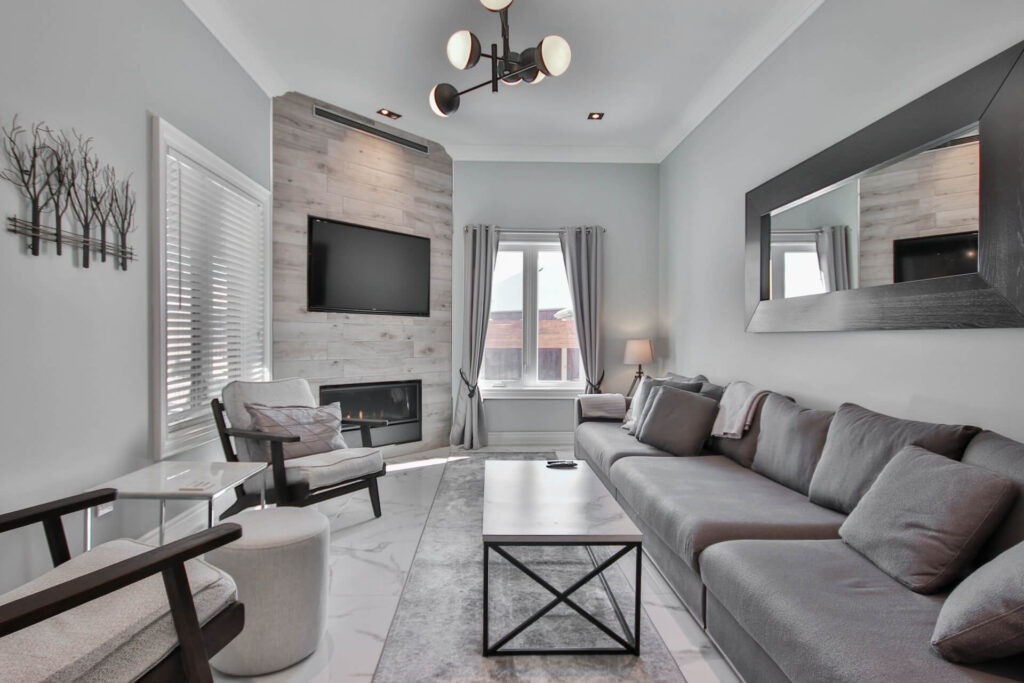Table of Contents
As we traverse the landscape of interior design in Singapore, we stumble upon a design theme that, while new, feels comfortingly familiar – Japandi. Japandi, a blend of the words “Japanese” and “Scandinavian,” has been the buzzword of the interior design world in recent years. But what is it about this unique fusion that is captivating homeowners across the globe? Well, let’s embark on a journey to explore the allure of the Japandi style and perhaps inspire you to infuse it into your own living space.
Japandi: Where East Meets West
At first glance, you might wonder how Japanese and Scandinavian design aesthetics, hailing from different ends of the world, could coalesce. However, they share a common thread: a profound reverence for simplicity, functionality, and the beauty of natural elements.
Japanese design cherishes the principle of Zen and the celebration of natural materials, reflecting a culture deeply rooted in mindfulness and tranquility. On the other hand, Scandinavian design focuses on minimalist beauty, practicality, and the creation of a cosy and warm environment – known as ‘hygge’ in Danish culture.
When these philosophies intertwine, the result is Japandi – an interior design theme that epitomizes the perfect blend of minimalism, functionality, comfort, and nature-focused aesthetics.
Incorporating Japandi into Your Home
So, how does one weave the essence of Japandi into their home? This transformation doesn’t necessarily mean an overhaul of your current decor. Instead, the journey to a Japandi-style home involves the thoughtful infusion of certain design elements that align with this aesthetic’s fundamental principles.
Choosing the Perfect Colour Palette
The heart of the Japandi style lies in its soothing and earthy colour scheme. To recreate this, focus on a muted, neutral palette that breathes tranquillity. Combine soft greys, beiges, and browns with gentle pastels to strike the right balance. The idea is to evoke a sense of calm serenity as soon as you step into your home.
Selecting the Right japandi style furniture
Japandi furniture embodies simplicity and functionality. The idea is to choose pieces that serve a purpose while maintaining a sleek, minimalistic aesthetic. Low-to-the-ground pieces, often seen in Japanese interiors, work well for this style. When selecting furniture, opt for items made from natural materials like wood, complemented by clean lines and a lack of unnecessary ornamentation.
Balancing Elements
An essential aspect of the Japandi style is the balance between elements, spaces, and even between the Japanese and Scandinavian influences. Every piece in your home should serve a purpose – this style shuns unnecessary clutter. When arranging furniture and decor, consider the flow of movement and the balance between the pieces and the free space around them.
The Role of Craftsmanship and Sustainability
Both Japanese and Scandinavian cultures have a deep appreciation for craftsmanship and sustainability. They believe in choosing well-made pieces that will stand the test of time, rather than opting for fast-furniture. Choose pieces that reflect this philosophy – not only does this make your home more sustainable, but it also gives it a sense of unique character.
Bringing Nature Indoors
Another critical aspect of the Japandi style is its focus on bringing elements of nature indoors. Indoor plants can purify the air and bring a sense of calm and peace into your home. Additionally, natural materials such as wood, stone, or jute can be incorporated into your furniture, flooring, and decorative pieces.
Who is Japandi Perfect For?
The Japandi theme is perfect for those who love simplicity, functionality,
and a touch of nature in their surroundings. It’s ideal for those who seek a minimalist yet warm and inviting living space.
Japandi is also a suitable interior design theme for small spaces. Its minimalistic and functional approach makes it possible to make the most out of a small space without making it look cluttered. Therefore, if you’re living in a bustling city like Singapore where space can be a luxury, adopting the Japandi style could be the perfect solution for you.
Moreover, if you’re a proponent of sustainable living, Japandi, with its focus on sustainable materials and quality over quantity, aligns perfectly with your principles.
Time to Embrace the Japandi Aesthetic
The Japandi style is more than just an interior design theme. It’s a philosophy that invites you to embrace a simpler, more mindful way of living. It encourages you to appreciate the beauty of nature, value the importance of quality and craftsmanship, and create a space that truly feels like home.
As Japandi continues to gain popularity in Singapore and beyond, we invite you to explore this unique style and consider how it can transform your home into a sanctuary of simplicity, functionality, and natural beauty. Are you ready to experience the uniqueness of the Japandi style in your home?
The Origins and Influences of Japandi Design Style
japandi style homes its inspiration from the traditional Japanese aesthetic of wabi-sabi, which embraces imperfections and the beauty of natural materials. It also takes cues from the Scandinavian design philosophy of minimalism, functionality, and simplicity. The combination of these two distinct styles results in a harmonious blend that is both calming and inviting.
The influence of Japanese design can be seen in the use of natural materials such as wood, bamboo, and paper, as well as the incorporation of traditional craftsmanship. On the other hand, Scandinavian design influences the clean lines, neutral color palettes, and functional furniture pieces that are characteristic of japandi interior design style. The result is a perfect balance between warmth and minimalism.
Key Characteristics of Japandi Style
how to decorate japandi style brings together the best of Japanese and Scandinavian design, resulting in a harmonious and serene aesthetic. By considering the following elements, you can successfully decorate your space in this unique style.
Simplicity and functionality are at the core of Japandi design. Embrace clean lines and uncluttered spaces to create a sense of calm and order. Opt for furniture with minimalist designs and a low-profile, focusing on practicality and versatility. The combination of Japanese minimalism and Scandinavian functionality ensures that every piece serves a purpose while adding visual appeal to the space.
Natural elements play a significant role in Japandi style. Incorporate materials like wood and bamboo to bring warmth, texture, and a connection to nature. Choose furniture and decor that showcase the natural beauty of these materials, further enhancing the tranquility of your space.
Neutral color palettes dominate the Japandi style, with earthy tones and muted shades taking center stage. These soft hues create a serene and inviting atmosphere, allowing for relaxation and contemplation. Introduce pops of color sparingly through carefully selected accessories or artwork to add visual interest without overpowering the overall aesthetic.
In Japandi style, less is more. Curate your decor thoughtfully, selecting a few key pieces that embody simplicity and elegance. Focus on quality rather than quantity, allowing each item to shine and contribute to the overall harmony of the space.
By embracing simplicity, functionality, natural elements, neutral colors, and a less-is-more approach, you can create a Japandi-inspired space that exudes tranquility, balance, and timeless beauty. Let the essence of this design style guide you in creating a home that reflects your personal taste and provides a serene sanctuary for everyday living.
Japandi-Inspired Room Designs
Now that we have explored the key characteristics, furniture, and color palette of Japandi style, let’s take a look at some room designs that embrace this unique aesthetic.
- Japandi Living Room: Create a cozy and inviting living room by incorporating a low-profile sofa, a sleek coffee table, and a minimalist bookshelf. Choose neutral-colored cushions and a soft rug to add warmth to the space. Add a touch of nature with a potted plant or a bonsai tree.
- Japandi Bedroom: Keep your bedroom minimalistic and clutter-free with a low platform bed, simple bedside tables, and a sleek wardrobe. Opt for light-colored bedding and curtains to create a serene atmosphere. Add a floor lamp or pendant light for soft, ambient lighting.
- Japandi Dining Room: Create a dining space that is both functional and stylish. Choose a minimalist dining table and chairs made from natural materials such as wood or rattan. Keep the color palette neutral and add a statement light fixture for a touch of elegance.
Japandi Style for Different Spaces in Your Home
japandi style dining room can be incorporated into various spaces in your home, creating a cohesive and harmonious aesthetic throughout. Whether it’s your living room, bedroom, dining room, or even your home office, japandi home style can bring a sense of tranquility and warmth to any space.
In your living room, opt for low-profile furniture, clean lines, and a neutral color palette. Add cozy throws and cushions for comfort, and incorporate natural elements such as plants or bamboo blinds to create a connection with nature.
In your bedroom, create a serene and minimalist space by choosing a low platform bed, simple bedside tables, and soft lighting. Keep the color palette muted and add texture through natural materials such as linen or jute.
For your dining room, choose a minimalist dining table and chairs made from natural materials. Keep the decor simple and elegant, with a focus on functionality and practicality.
And finally, in your home office, create a clutter-free and organized space with functional furniture and minimalistic decor. Choose a desk made from natural wood and incorporate storage solutions that blend seamlessly with the overall aesthetic.
Japandi Style in Singapore Interior Design
Japandi style has made its way into the world of Singapore interior design, with many homeowners embracing its simplicity and tranquility. The clean lines, natural materials, and muted color palette of Japandi style resonate well with the fast-paced lifestyle of Singaporeans.
In Singapore, where space is often limited, Japandi style offers a practical and functional approach to interior design. The minimalist furniture and clutter-free spaces create an illusion of spaciousness, making it an ideal choice for small apartments and homes.
Many interior designers in Singapore have incorporated Japandi elements into their designs, creating spaces that are both aesthetically pleasing and functional. From minimalist kitchens to serene bedrooms, Japandi style has become a popular choice among homeowners looking to create a sense of calmness and tranquility in their homes.
Conclusion: Embrace the Tranquility of Japandi in Your Home
As we conclude our exploration of Japandi style, it’s clear that this unique design aesthetic offers a perfect blend of tranquility, functionality, and natural beauty. By incorporating elements of Japanese minimalism and Scandinavian simplicity, Japandi style creates a harmonious and inviting atmosphere in your home.
From the furniture and decor to the color palette and materials, every aspect of Japandi style is carefully curated to promote a sense of calmness and serenity. Whether you live in a small apartment or a spacious house, Japandi style can be adapted to suit any space and bring a touch of tranquility into your life.
So why not embrace the uniqueness of Japandi style in your home? Create a space that reflects your personal style while promoting a sense of harmony and relaxation. Let the tranquility of Japandi style envelop you as you unwind and recharge in the comfort of your own home.

